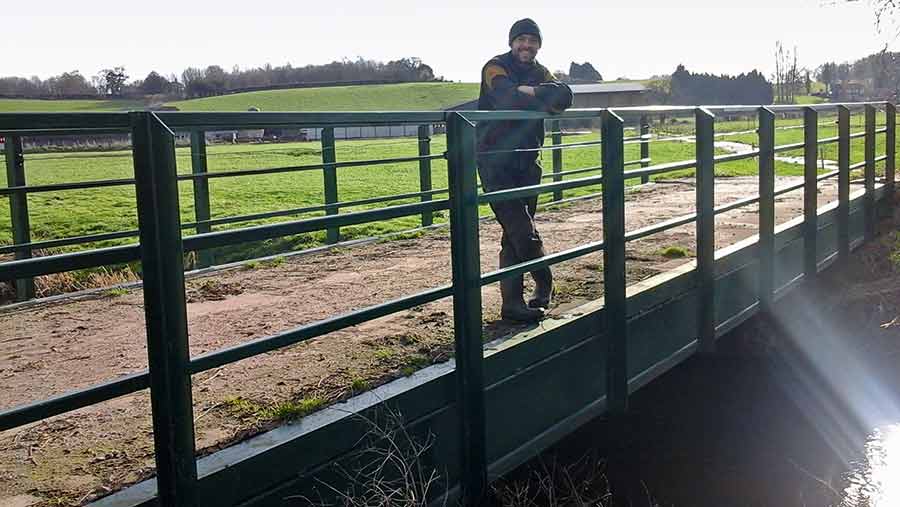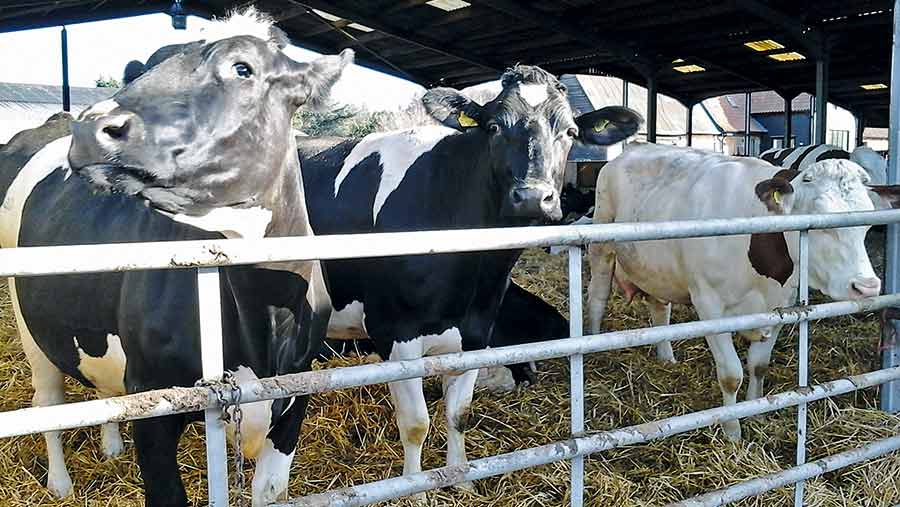Dairy farmers construct £12,000 bridge to access pasture
Building a bridge has allowed one Suffolk dairy farm to reduce its reliance on purchased feed by improving access to pasture.
Suffolk dairy farmers Jonny Crickmore and his father Graham have built a bridge to access an extra 22ha of marshland for grazing, knocking up to 10p/litre off their cost of production.

The Crickmore’s 300-strong milk herd was previously prevented from accessing a large section of grassland by the River Waveney – the border of Suffolk and Norfolk – which cuts through their land.
In 2014, they completed construction of a £12,000, 15.5m Bailey bridge across a stretch of the river after first being convinced to get back into grazing by AHDB Dairy extension officer Shirley Macmillan.
See also: How quality forage upped farm’s milk from forage and yields
“We had a limited amount of grass we could graze,” says Jonny, who estimates a figure of 65ha. “We were grazing all our paddocks and having to buffer feed the cows at certain points of the year because there just wasn’t enough grass.
“Meanwhile, we had these 22ha of marsh on the other side of the river in Norfolk.
“Once we had the grass paddocks set up on this side of the river, building a bridge to access the other side seemed to be the next logical step,” he says.
Farm facts
- 385ha
- 800-900 cattle depending on time of year, including 300 milking cows plus followers
- Stocking rate of 2 cows a hectare grazing
- Produces 2.2m litres/year
- 88-90% of milk produced sold to Muller (previously Dairy Crest)
- More than 4,000 litres of raw milk sold a month online and through on-site vending machine
- Cheese and butter also produced on farm
Planning permission
In December 2013, Mr Crickmore enlisted the help of local consultants, who sought planning permission on the Crickmores’ behalf.
The River Waveney is a main river, meaning permission to build the bridge was required from the Environment Agency rather than local authorities.
“They helped us get planning permission, which involved the Environment Agency – getting the all clear with them – and checking for voles in the banks and all of that.”
Although the Environment Agency “was more concerned the bridge would be a flood obstacle,” says Mr Crickmore, “hence we had to have this one-in-a-hundred-year flood level reach at the bottom of the bridge. That meant we had to get this survey company to come out.”
With permission granted, the Crickmores began work on the bridge in May 2014.
“Because of the length of the bridge we didn’t think we had enough knowledge on bridge building so we had a structural engineer design the bridge,” says Mr Crickmore.
“Once we got the right drawings, we ordered the metal and concrete and built it ourselves. It was just a case of working it out with the tools we had on the farm.”
Whose permission do you need?
Prior to carrying out maintenance on, over, under or near a main river (typically a large stream or river) farmers may require a Flood Defence Consent licence from the Environment Agency.
Those looking to build on, over, under, or near an ordinary watercourses (every river, stream, ditch, drain, sewer or water passage that does not form part of a main river) must instead contact their Internal Drainage Board or local council for permission.
Before applying for a Flood Defence Consent licence, the Environment Agency recommends you contact it for advice on your proposal.
See if any main rivers lie on your land on the Environment Agency map.
The Environment Agency is obliged to reply to your application within two months.
See also: 10 most common cross-compliance breaches and how to avoid them
First, wide footings were dug on each bank and concrete plinths inserted. “We did a wide footing rather than a deep one to spread it across more surface area. Then we inserted concrete plinths, which had to be to a certain height for the one in a hundred flood level reach.
“With a telehandler on one side of the river and another on the other we pushed and pulled the RSJs [rolled steel joists] over two long telegraph poles, which spanned the river on rollers.
“Once all five RSJs were in place we brought in a generator and welded together all the cross sections of the bridge.
“We then brought one concrete panel at a time, dropped it down closest to where the teleporter was driving. Then we dropped the next one and drove over the river as we lay each concrete panel down until we got to the last panel on the other end.”
It was then just a case of welding angle iron over the ends of the panels, installing side rails and painting it green, he says.
“It was built to withstand 12t, but true to farmer style we took an 18t load of muck over it last summer and it seemed all right. We just went over it quickly.”
Payback
Pre-bridge, cows on Fen Farm had access to around 65ha of forage. Now, with the bridge in place and a path of concrete railway sleepers from the milking shed, the Crickmore’s herd has access to an extra 22ha of grass.

The 300-strong milk herd, which is made up of 150 Montbeliarde, 50 Holstein, 100 cross-bred Montbeliarde Holstein and Brown Swiss Holstein, now graze the farm’s 40 paddocks – two a day – on a three-week rotation.
“We try to keep the cows out for eight months of the year – we don’t graze November, December, January and February,” he says.
“It was the same [before the bridge]. The difference is that we would have run out of grass in the middle of the summer when it starts to dry up. At that point we would have been buffer-feeding silage.
“Now, there’s more paddocks and more grass, so it lasts longer,” he adds.
See also: Underpasses enable Irish milk producer to double herd size
Costs
The Crickmores spent around £12,000 installing the Bailey bridge, including £1,500 to secure planning permission, £1,000 paid to the structural engineer, £6,000 on metal, and £3,000 on the concrete panels. Looking back, Mr Crickmore considers it a good investment.
By increasing access to forage and reducing the need for TMR, Mr Crickmore estimates he is saving between 7-10p/litre.
“It’s very difficult to say [how much the farm is saving as a result of the investment], but I think you could quite comfortable say that with the money you save with extra grazing the bridge will pay for itself within a couple of years.
“We were spending half an hour driving over to the other side of the river to bring silage home and only putting youngstock on it when we could have had milking cows graze it.
“Whether you’re getting 21p/litre or 34p/litre, the 2p/litre cost of eating grass is a hell of a lot cheaper than 10-14p/litre for TMR.
“At the end of the day I know soya costs me £280/t. If I don’t put soya in the mix wagon and the cow bins that saves me £280/t,” he says.
“There’s also the mixer wagon running and the teleporter putting the food in the mixer wagon. It’s all done away with when they’re just walking out there and eating off the ground.”
Another bridge?
The Crickmores are now considering installing a second bridge across the Waveney to connect its newly accessible land to another 16ha of marshland further downstream.
“[With the bridge] it’s a matter of going from our farm in Suffolk across the river to Norfolk. But we’ve got other marshes back in Suffolk on the other side of some houses that we currently have to get to via the road.
“So it would be a case of building a bridge going back into Suffolk from Norfolk to get to those in Norfolk.
“It takes the best part of three-quarters of an hour everyday going down there with two or three people to get cows off the road. Also, the cows have to go in one go from the milking parlour. Whereas with another bridge they could go when they feel.”
For those farmers faced with a similar situation, Mr Crickmore says building a bridge is an obvious solution.
“I would say to any farmer, think about how much time it takes each day to drive to the nearest bridge to get to the other side of a river.
“When you’re spending half an hour every day going around a river and over a bridge there would definitely be payback there – just in time alone.
”If you’ve got a herd of cows that could potentially graze more as opposed to feeding them in the shed because you simply don’t have enough grass then it’s a no brainer really, isn’t it?”
Jonny Crickmore’s top tips on building a bridge
Think about movement
“If you’re going to weld loads of big lumps of metal together you need to allow for the bridge to move over time. Otherwise, all your welds will crack. It you don’t weld I would recommend putting bolts in instead,” says Mr Crickmore.
“We also placed rubber on top of the concrete plinths and underneath the RSJs to allow for more movement as the ground is going to move over time.”
For a big bridge, get a structural engineer to design it
“For the cost, it is definitely the best move,” says Mr Crickmore.
Think about what you’ll drive over it before deciding on load capacity
“The reason we put down five RSJs was that the second and the fourth basically fall where your wheels will go,” says Mr Crickmore. “The concrete panels are strong, but by having an RSJ underneath where you’ll drive you’re making the bridge stronger still.”
